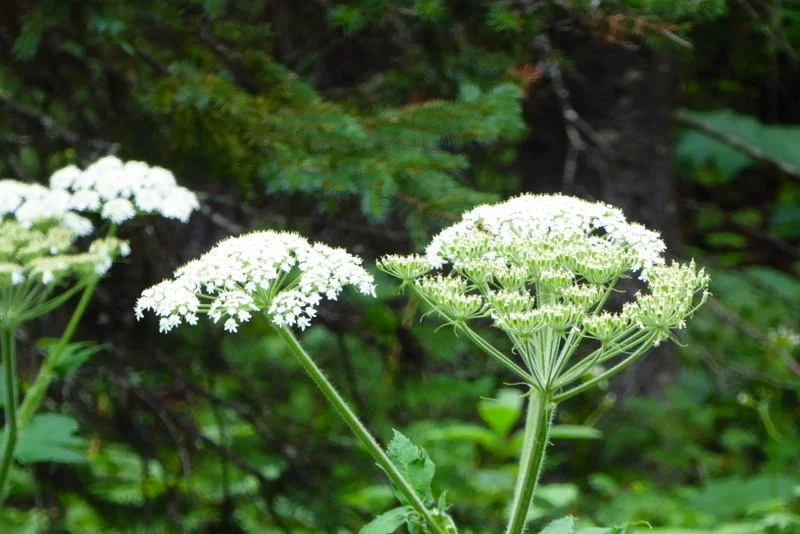What are the Bears eating today?
by Derek Ryder, Wildlife Ambassador & IGA Interpretive Guide
Living and recreating safely in bear country means understanding many things, from signs that bears are around to what to do in a bear encounter. As we wander in the wilderness (or even in town sites) we are travelling in bears’ homes: their living areas, dining areas, and even their bathrooms. Recognizing food that bears are currently eating can help raise your awareness of the possibility that bears are around where you are at any given moment. In this series of articles, each month, we’re going to look at what bears are eating right now, and for the next few weeks.
At this time of year, as berry season fades in the valleys and frost kills the berry plants, most Grizzlies are now up in the alpine. Now that they’re up there, the first and easiest plant they’ll find to eat is Cow Parsnip with their tall, distinctive white flowers.
Remember, bears hunt with their noses and Cow Parsnip flowers… stink. Find a marshy, wet spot, or creek or river course anywhere in K-Country, and you’ll find Cow Parsnip. You can’t miss it by late September; it has grown to 6’ tall before deep freezes (which we have not had yet) kill it off. And best for bears: the roots are still edible after it’s dead.
Grizzlies eat Cow Parsnip in both spring and fall shoulder seasons. All parts of the Cow Parsnip are edible for bears. Stems and roots are high in fibre but low in protein, only on the order of 10%; leaves are up to 30% protein. However, given their druthers (and a lot of Cow Parsnip), they’ll first eat the stems, next dig up the roots, and skip leaves entirely. The leaves are huge and can’t be missed, as shown in the photo above.
One dead giveaway a bear has been chowing down on Cow Parsnip is a sea of dead Cow Parsnip leaves around chopped off stems. That’s a common sight at this time of year in places like the Commonwealth Valley on the way to the Birdwood Lakes, or in Pocaterra & Ptarmigan Cirque – where everyone goes to see larches at that time! It’s no wonder we have conflict at larch season. Anywhere you’ll find larches, you’ll find Cow Parsnip – and grizzly bears.
Cow Parsnip may be good for bears, but it’s not wise for you to touch it. It contains furanocoumarins in the plant’s sap. Get that on your skin and expose it to a bit of sunlight and I guarantee you’ll get itchy, red rashes and possibly blisters. The Bow Valley Stewards remove Cow Parsnip from places like Camp Chief Hector, and whenever we do that, we almost have to wear hazmat suits.
That having been said, if you can figure out how NOT to get sap on you, Cow Parsnip is really edible. Peel the outer stem, and you can eat the inner stem raw or by cooking it. Dig up the roots and you have yourself something similar to a parsnip (probably why they’re called Cow Parsnip, but I’m not enough of a biologist to know if the two plants are related).
If you see dead Cow Parsnip stems, you’ll note they are fibrous, tough and hollow; you can make flutes and whistles from them, but realize those furanocoumarins may still be there and your lips could sting.
Cow Parsnip would also be on a Black Bear’s diet list, except there’s not much Cow Parsnip in the Bow Valley. Plus, research shows Black Bears seem to prefer their Cow Parsnip more in spring than fall. Instead, Black Bears around town eat grasses and kinnikinnik spring and fall either side of berry season. The black bear scat I’ve seen in the last few weeks down in the valley has been just that. The photo above is scat from one of the three black bears hanging in my neighbourhood and pooping on our streets.
If you’re going larch-peeping, keep your eyes out for Cow Parsnip. If you see a dense patch like the one in the picture (and yes, every white dot is a Cow Parsnip, and most aren’t even flowering), make a ton of noise, and watch for tall plants swaying where they shouldn’t be. Watch along your way for giant dead leaves and possibly dug up plants. These are the dead giveaways you’ve just walked into a bear’s dining room, and they aren’t paying attention to you.
Click here to find out ‘What the bears are eating’ in other months!

